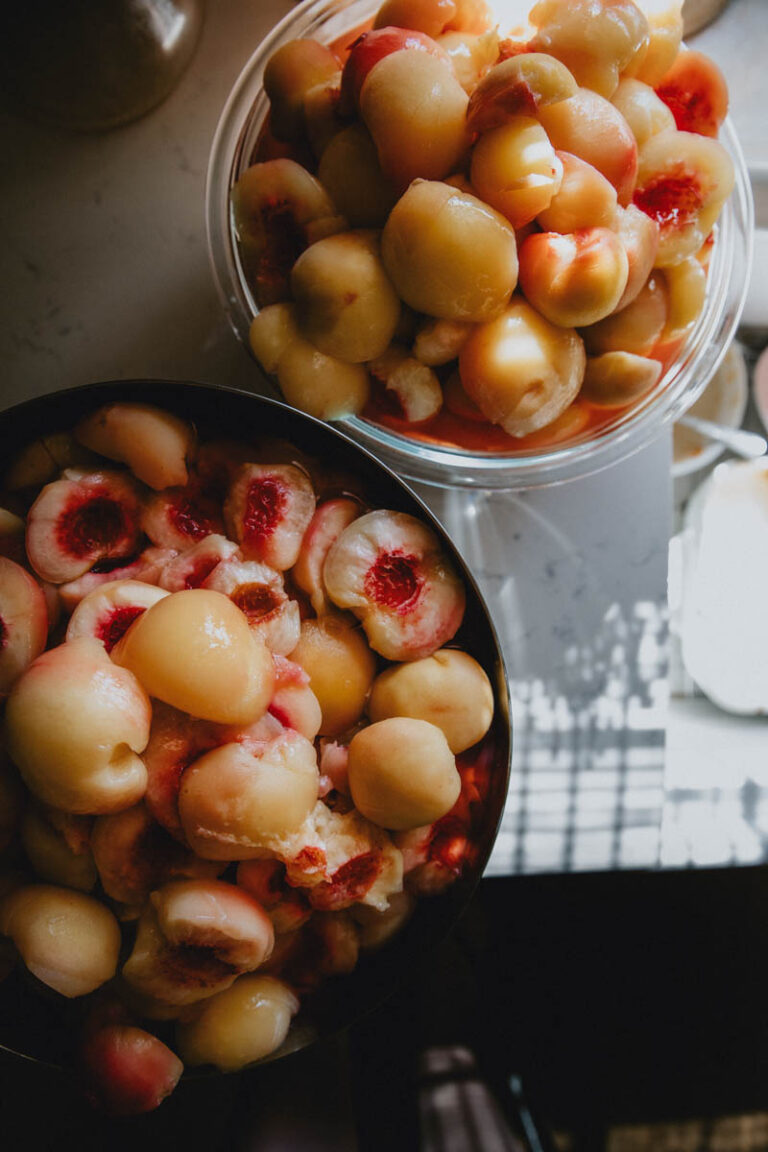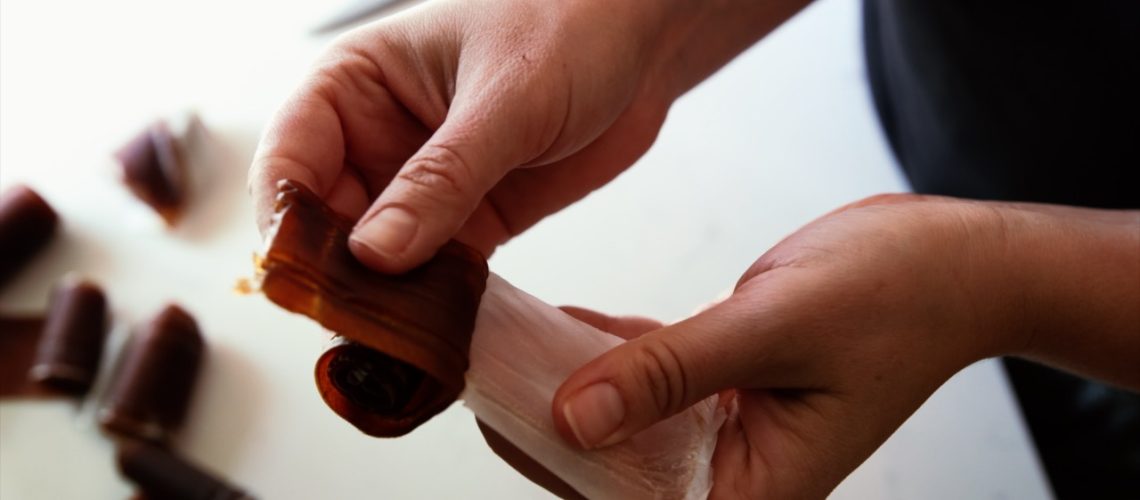Learn to make ginger peach fruit leathers the easy way with this simple recipe and tutorial. Approved by kids and adults alike!

Fruit roll-up’s were one of my favorite snacks as a kid. My siblings and I would gleefully unwrap them and spend our afternoons savoring the sweet treat. There’s something so fun about a snack that just keeps unraveling!
Of course, those fruit roll-up’s were full of artificial flavors and dyes and not one ounce of real fruit. These days you can find 100% fruit leathers and roll-up’s at the grocery store, but they tend to be expensive and my kids go through them too quickly for my liking.
That’s where these homemade treats come in! During peach season our tables were overflowing with boxes full of peaches, fresh-picked from our friend’s orchard. Our own orchard is still tiny and growing, so for now we like to help our friends pick their peaches while we wait for our own.
The peaches were juicy and overripe and needed to be processed quickly. Since I had already made lots of roasted peach jam, I thought some peach fruit leathers would be a quick and easy project!
Nothing pairs better with fresh peaches than ginger, in my opinion. But if you aren’t a fan of ginger, feel free to leave it out and use cinnamon or vanilla or just plain peach instead!
Why Make Fruit Leathers in the Dehydrator?
Like most simple recipes, there’s about a thousand variations on how to make fruit leathers. The way I chose to make mine was in the dehydrator because I knew it would be hands-off and easy. If you have a smaller, round shaped dehydrator you can still make these fruit leathers. You’ll just want to get silicone molds that can fit your dehydrator. I found these ones with a rim that worked great for my Sedona Express dehydrator.
I also chose to cook down the fruit puree before dehydrating to help speed up the process. This only takes a few minutes, but resulted in a really flavorful fruit leather that didn’t take a million years to dehydrate.
Even if you don’t have a dehydrator you can still make these ginger peach fruit leathers. Just pop them in the oven on a baking sheet layered with parchment paper and bake on the lowest temperature you can! Be sure to check them every so often to make sure they’re not burning. This blogpost details a method for making fruit leather in the oven, if you wish to try a recipe specifically designed for the oven!

How Long Does it Take to Make Fruit Leather?
The amount of time it takes to make fruit leathers depends on your dehydrator. My Sedona Express dehydrator allows me to choose a “fast” or “raw” setting, and set custom temperatures. On a fast setting I can make fruit leather in as little as 4-5 hours dehydrating time!
With the prep time of cutting peaches and cooking them into a thick mash it takes me about 6 hours to make these fruit leathers. I cut some time off by not skinning my peaches. Our Vitamix blender purees so well I wasn’t worried about it. We didn’t notice the skins at all, but if you are sensitive to peach skin you could choose to blanche and peel them first.
How Do You Make Peach Fruit Leather?
Fruit leather is super easy to make. The general process is to pit the peaches, peel and dice the ginger (if using), and blend them in a blender or food processor. Then cook the ginger-peach mixture over medium-low heat on the stove until it thickens to the consistency of applesauce. Add sweetener if desired. After that you can cool it slightly and then pour onto silicone mats or parchment paper. Place into the dehydrator (or oven) and dehydrate until no longer tacky. Then place the sheets of fruit leather onto wax or parchment paper (if you didn’t already) and cut into long strips. Roll them up and store in a jar in the pantry or in the fridge if you tend to have a lot of humidity.
The fruit leather will keep for a couple weeks in an airtight jar stored at room temperature, and a few weeks in the fridge. But it barely lasts more than a few days in our home!
Ginger Peach Fruit Leather Variations
Because this tutorial is more of a method than a strict recipe, it’s easy to change up the flavors to your liking!
You can omit the ginger and add a few vanilla beans or a couple teaspoons of vanilla extract. You could sprinkle in some cinnamon, or even cardamom for a spicy variation. If you want a boozy adult version you could add bourbon (just note the alcohol will cook off before you dehydrate).
We found this ginger peach version, coupled with a bit of maple syrup for sweetener, was just perfect for kids and adults alike.

Okay, so here’s the deal. This is more of a method with helpful suggestions for amounts of ingredients rather than a regimented recipe. And there’s a good reason for that. Peaches vary in sweetness, juiciness, and texture. Besides, everybody has their own unique taste preferences. Who am I to tell you how sweet or tangy or flavorful to make your fruit leathers?
The good news is, it’s hard to mess up something this simple. My biggest advice? Try the puree before you dehydrate it. Make adjustments in the pot. Add more sweetener or spices or whatever else you think it needs before you turn it into leather.
Ginger Peach Fruit Leather
Equipment
- Dehydrator (or oven on the lowest setting)
- Blender (or food processor)
Ingredients
- 3 lbs Peaches pitted and cut in half
- 1 1.5 inch Piece of Ginger peeled and diced
- 1/4 cup Pure Maple Syrup optional
Instructions
- Wash, halve, and pit your peaches. If their skins are especially thick and fuzzy, or if you're worried about pesticide residue, you can peel them. We left the peels on for a quicker process and never noticed them!
- Add the peaches and about a 1.5 inch piece of ginger root, cut and peeled, to the blender and process until perfectly smooth. This took just a few seconds in our Vitamix. If your peaches aren't particularly juicy you may want to add a cup or so of water.
- Pour the peach ginger puree into a medium size stock pot and cook over medium heat. Stir frequently to avoid burning, and let the puree simmer until it has thickened to about the consistency of apple sauce and the water or juice has mostly cooked down.
- Once the puree has thickened in the stock pot, stir in your sweetener. You'll want to do this to taste. We like a tart fruit leather, so a quarter cup of maple syrup was plenty of sweetener for us. But you can always add more, or use cane sugar if you want a much sweeter result.
- Allow the peach mixture to cool for twenty minutes or so. Taste the puree and adjust the sweetness or seasonings. If you're adding cinnamon or cardamom or any other spices, now's the time to do it!
- Pour the peach puree onto your silicone dehydrator mats and smooth out with a rubber spatula. The puree should be about 1/8 inch thickness. You can pour directly on the mats for a smoother result. We poured onto parchment paper, and had some little creases and lines in our fruit leathers. Either way is fine.
- Dehydrate the fruit leathers for 4 hours at 135°F ("fast mode" on the Sedona Express Dehydrator). After 4 hours, check the fruit leathers for tackiness. If they still feel sticky, continue to dehydrate until they're chewy and not so sticky. For us this ended up being about 5 or 6 hours. You can flip the fruit leathers over on the trays about halfway through if you want to speed up the process.
- When the fruit leathers are the perfect texture, pull them out and let them cool, then cut into strips and roll up! Store in a jar in the pantry for a few days, or in the fridge for a few weeks – if they even last that long!
So that’s it! My simple method for making the tastiest ginger peach fruit leathers you’ve ever tasted. And at a fraction of the cost of store bought fruit leathers too!
If you try this recipe I’d love to hear how it turned out! Leave a comment and tell me how you liked it and whether you changed up the recipe. Happy snacking!




One Response
1 tin peaches in syrup.
Drain off syrup.
1 knob (2″) ginger washed, leave skin on, sliced.
Add peach slices and ginger slices to blender _ blend till smooth
65⁰C for 6 hours in dehydrator.
Perrrrrfect.